


PIERO DELLA FRANCESCA c1415 -
(H5, H6, E4, E5, R3, H7)
xxxxxThe frescoes and panel paintings of the Italian Piero della Francesca, a mathematician as well as an artist, are noted for their disciplined use of colour and perspective which, combined with a simplicity and clarity of composition, create a feeling of grandeur and serenity. He learnt from the works of Masaccio and Fra Angelico, but also developed an individual style. This is best seen in his series of frescoes for the church of San Francesco in Arezzo, begun in 1452. Tracing the history of the wood upon which Christ was crucified, these scenes, noted above all for their solemnity and the limpid beauty of their colours, are now numbered among the treasures of the Italian Renaissance. Most of his work is on religious subjects, such as The Madonna of the Misericordia ,The Flagellation of Christ, and The Nativity, but he is also well known for his profile portraits of the Duke and Duchess of Urbino. He influenced the style of Giovanni Bellini, but his purity of form and his mastery of colour, light and perspective were not fully appreciated until the 20th century.
aaaaaPiero della Francesca 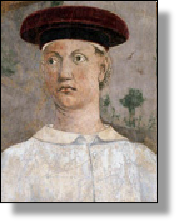 was born in the small town of Borgo san Sepolcro, about 40 miles south-
was born in the small town of Borgo san Sepolcro, about 40 miles south-
aaaaaHis movements are somewhat sketchy. He worked in Florence in the late 1430s, painting frescoes in the church of Sant’Egidio (since destroyed), and studying all the forms of early Renaissance art. He was particularly influenced by the work of Masaccio and Fra Angelico, and it was here that he became acquainted with Alberti’s theories on perspective, contained in his Della Pittura (On Painting) of 1436. It was on his return to Borgo that, amongst a number of panel paintings and frescoes, he produced his earliest known work The Madonna of the Misericordia, an altarpiece begun in 1445. This is thought to contain a self-
aaaaaIt was in 1452 that 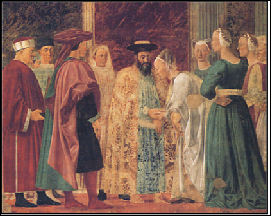 he began work on his largest commission, the Arezzo frescoes. Today regarded as his masterpiece, they decorate the choir in the church of San Francesco. In keeping with the mania for religious relics at this time, they tell the Story of the True Cross. Based on a collection of medieval legends, they trace the history of the wood on which Christ was crucified. When completed some twelve years later it contained some of the most beautiful scenes in Christian art, including The Meeting of Solomon and the Queen of Sheba (detail illustrated here), the Exaltation of the Cross, the Battle between Heraclius and Chosroes, and the Discovery and Proof of the True Cross (the last two illustrated below). Despite the damage these frescoes have suffered over the years, they still inspire by the freshness of their soft, muted tones and -
he began work on his largest commission, the Arezzo frescoes. Today regarded as his masterpiece, they decorate the choir in the church of San Francesco. In keeping with the mania for religious relics at this time, they tell the Story of the True Cross. Based on a collection of medieval legends, they trace the history of the wood on which Christ was crucified. When completed some twelve years later it contained some of the most beautiful scenes in Christian art, including The Meeting of Solomon and the Queen of Sheba (detail illustrated here), the Exaltation of the Cross, the Battle between Heraclius and Chosroes, and the Discovery and Proof of the True Cross (the last two illustrated below). Despite the damage these frescoes have suffered over the years, they still inspire by the freshness of their soft, muted tones and -

aaaaaPiero spent the last twenty years of his life in his home town, where he passed some of his time studying mathematics and philosophy. To this period, however, belongs, one of his greatest frescoes, The Resurrection (now in the Palazzo, the town’s museum and art gallery), and one of his last surviving works, his unfinished Nativity, begun around 1470 and now in the National Gallery in London. It would appear that his sight began to fail when he was about 60 (1475) and that he was blind in the last two or three years of his life. He was buried in the family grave in the Abbey of Sansepolcro.
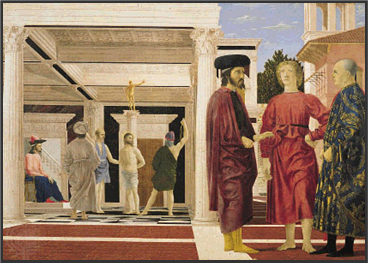 aaaaaPiero’s style is highly individualistic. As would be expected of these times, nearly all his works have a religious theme and are painted in fresco or on wooden panels, but, fascinated as he was by mathematical order, they possess distinctive qualities based on precision and clarity. In his masterly use of colour and light, for example, he combines a harmony of muted, limpid tones with a feeling of cool, airy space, best seen in his The Nativity and a number of his Arezzo frescoes. And by his close study of perspective he creates a realistic sense of depth, especially notable in his detailed architectural study of the receding floor and ceiling in The Flagellation of Christ (here illustrated), and the marble apse which is situated above and, seemingly, behind The Madonna and Child with Saints and Angels. In his Resurrection he employs perspective and foreshortening to heighten the emotion of the scene and its symbolic meaning. Towards the end of his life he wrote three books on the subject of perspective, the best entitled On Perspective in Painting. And such was his knowledge that while in Urbino he gave lessons to Donato Bramante, the Italian architect who made the first designs for the new Basilica of St. Peter in Rome.
aaaaaPiero’s style is highly individualistic. As would be expected of these times, nearly all his works have a religious theme and are painted in fresco or on wooden panels, but, fascinated as he was by mathematical order, they possess distinctive qualities based on precision and clarity. In his masterly use of colour and light, for example, he combines a harmony of muted, limpid tones with a feeling of cool, airy space, best seen in his The Nativity and a number of his Arezzo frescoes. And by his close study of perspective he creates a realistic sense of depth, especially notable in his detailed architectural study of the receding floor and ceiling in The Flagellation of Christ (here illustrated), and the marble apse which is situated above and, seemingly, behind The Madonna and Child with Saints and Angels. In his Resurrection he employs perspective and foreshortening to heighten the emotion of the scene and its symbolic meaning. Towards the end of his life he wrote three books on the subject of perspective, the best entitled On Perspective in Painting. And such was his knowledge that while in Urbino he gave lessons to Donato Bramante, the Italian architect who made the first designs for the new Basilica of St. Peter in Rome.
aaaaaAnd no less striking 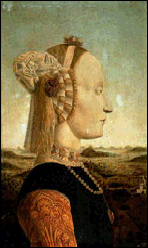 was
was 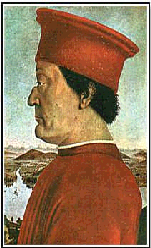 the composition of his figures -
the composition of his figures - dignified, impassive and with a classical severity reminiscent of ancient Greek statutory and the stiff style associated with Byzantine art. Yet though his figures are “wooden”, and their faces virtually devoid of expression, they nonetheless succeed in conveying the serenity and confidence of religious conviction. And even his battle scene, part of his Arezzo series, though devoid of any movement, appears as a gory conflict frozen in time. Nor was he without skill as a portrait artist, as his portrayal of the Duke and Duchess of Urbino clearly shows here.
aaaaaBecause he spent most of his days in the small town of Borgo san Sepolcro, his frescoes and panel paintings were little known during his lifetime. His work did influence some, including the Venetian artist Giovanni Bellini, but tended to be forgotten not long after his death. In any case, his paintings were too self-
aaaaaIncidentally, The Flagellation of Christ (illustrated above) is one of the most beautiful and, at the same time, most puzzling paintings in the history of art. It is made up of two separate scenes. The foreground to the right of the painting is dominated by a group of three men, whilst the flagellation itself, pictured on the left, is relegated to the background. Over the years many theories have been put forward to explain or identify these three mysterious figures, but none has come up with a definitive connection between these two scenes. ……
aaaaa…… In 1459 he was invited to Rome by pope Pius II to decorate his bedroom in the Vatican. Unfortunately, his frescoes deteriorated quite rapidly and early in the 16th century the Italian master painter Raphael was commissioned by Pope Julius II to paint over them. ……
aaaaa…… Two of his best known works were his pair of portraits in profile of the Duke and Duchess of Urbino, produced around 1465 (illustrated above). Profile portraits were in vogue at this time, but in the case of the Duke, Federigo da Montefeltro, this view was chosen for a personal reason. Some years earlier he had lost his right eye and badly damaged his nose while taking part in a tournament.
Including:
Pisanello

aaaaaAnother Italian artist who, like Piero, made a close study of perspective and foreshortening was Antonio Pisano, known as Pisanello, (c1395-
aaaaaAs a painter 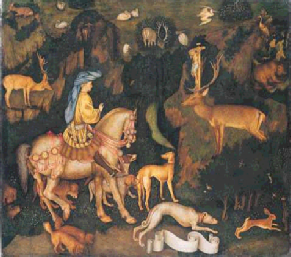 he was
he was 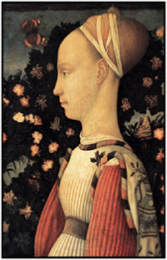 much influenced by the gothic style of his mentor Gentile da Fabriano, with whom he worked on frescoes in the Doges’ Palace, Venice, and in St. John Lateran in Rome. But of the frescoes he executed only two remain in Verona: his Annunciation and his Saint George and the Princess, a work particularly noted for its close observation, its rich, tapestry-
much influenced by the gothic style of his mentor Gentile da Fabriano, with whom he worked on frescoes in the Doges’ Palace, Venice, and in St. John Lateran in Rome. But of the frescoes he executed only two remain in Verona: his Annunciation and his Saint George and the Princess, a work particularly noted for its close observation, its rich, tapestry-

aaaaaBut in h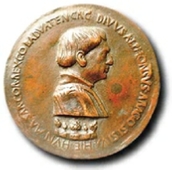 is day, Pisanello’s fame
is day, Pisanello’s fame 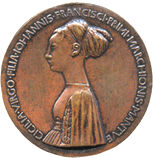 rested more upon his portrait medals than upon his drawing or painting. Indeed, he it was who, after studying Greek and Roman headed-
rested more upon his portrait medals than upon his drawing or painting. Indeed, he it was who, after studying Greek and Roman headed-
aaaaaIncidentally, after the Second World War a fresco by Pisanello depicting horsemen and soldiers was discovered in one of the rooms in the Ducal Palace at Mantua.
xxxxxAnother Italian artist who, like Piero, experimented with perspective, was Antonio Pisano, known as Pisanello (c1395-



Acknowledgements
Piero: Self Portrait, detail in the Discovery and Proof of the True Cross, Fresco, San Francesco, Arezzo; The Meeting of Solomon and the Queen of Sheba – Fresco, San Francesco, Arezzo; Battle between Heraclius and Chosroes – Fresco, San Francesco, Arezzo; The Discovery and Proof of the True Cross – Fresco, San Francesco, Arezzo; The Flagellation of Christ – Galleria Naxionale delle Marche, Urbino; Duchess of Urbino – Uffizi Gallery, Florence; Duke of Urbino – Uffizi Gallery, Florence, Pisanello: Vision of St. Eustace – National Gallery, London; Princess of the House of Este – The Louvre, Paris; Animal drawings – The Louvre, Paris.
H6-